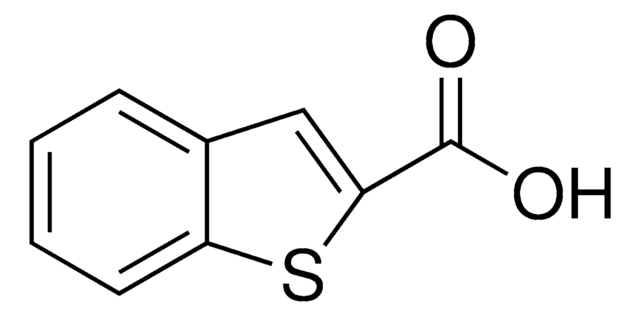C85603
Coumarin-3-carboxylic acid
99%
Synonym(s):
2-Oxo-2H-1-benzopyran-3-carboxylic acid
Sign Into View Organizational & Contract Pricing
All Photos(1)
About This Item
Empirical Formula (Hill Notation):
C10H6O4
CAS Number:
Molecular Weight:
190.15
Beilstein:
154276
EC Number:
MDL number:
UNSPSC Code:
12352100
PubChem Substance ID:
NACRES:
NA.22
Recommended Products
Quality Level
Assay
99%
form
powder
mp
189-192 °C (lit.)
SMILES string
OC(=O)C1=Cc2ccccc2OC1=O
InChI
1S/C10H6O4/c11-9(12)7-5-6-3-1-2-4-8(6)14-10(7)13/h1-5H,(H,11,12)
InChI key
ACMLKANOGIVEPB-UHFFFAOYSA-N
Gene Information
human ... PTPN1(5770)
Looking for similar products? Visit Product Comparison Guide
Signal Word
Danger
Hazard Statements
Precautionary Statements
Hazard Classifications
Acute Tox. 3 Oral
Storage Class Code
6.1C - Combustible acute toxic Cat.3 / toxic compounds or compounds which causing chronic effects
WGK
WGK 3
Flash Point(F)
Not applicable
Flash Point(C)
Not applicable
Personal Protective Equipment
dust mask type N95 (US), Eyeshields, Gloves
Choose from one of the most recent versions:
Already Own This Product?
Find documentation for the products that you have recently purchased in the Document Library.
Customers Also Viewed
A Karaliota et al.
Journal of inorganic biochemistry, 84(1-2), 33-37 (2001-05-02)
The copper(II) complex of coumarin-3-carboxylic acid (CcaH) has been prepared and characterized on the basis of elemental and thermal analysis, IR, Raman, EPR, UV-Vis reflectance and 1H-NMR spectra. A detail analysis of all spectra data is presented with particular emphasis
Grigory V Andrievsky et al.
Free radical biology & medicine, 47(6), 786-793 (2009-06-23)
Aqueous solutions of highly stable supramolecular donor-acceptor complexes of chemically nonmodified pristine C(60) fullerene molecules with H(2)O molecules (hydrated C(60) fullerene-C(60)HyFn) and their labile nano-sized clusters were examined for their antioxidant effects on removal of hydroxyl radicals (.OH) and protecting
Rajsekhar Roy et al.
ACS omega, 5(30), 18628-18641 (2020-08-11)
In Alzheimer's disease (AD), insoluble Aβ42 peptide fragments self-aggregate and form oligomers and fibrils in the brain, causing neurotoxicity. Further, the presence of redox-active metal ions such as Cu2+ enhances the aggregation process through chelation with these Aβ42 aggregates as
M A Ali et al.
Free radical research, 32(5), 429-438 (2000-04-15)
The effect of lactic acid (lactate) on Fenton based hydroxyl radical (*OH) production was studied by spin trapping, ESR, and fluorescence methods using DMPO and coumarin-3-carboxylic acid (3-CCA) as the *OH traps respectively. The *OH adduct formation was inhibited by
Dan Wang et al.
Acta biomaterialia, 65, 327-338 (2017-11-08)
The accumulation of the extracellular β-amyloid (Aβ) aggregates with metal ions in conjunction with reactive oxygen species (ROS) is closely related to the pathogenesis of Alzheimer's disease (AD). Accounting on Cu ions chelating of our previously designed bifunctional peptide GGHRYYAAFFARR
Our team of scientists has experience in all areas of research including Life Science, Material Science, Chemical Synthesis, Chromatography, Analytical and many others.
Contact Technical Service










